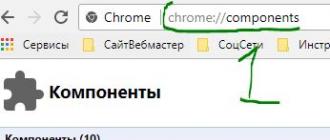Создание простой системы регистрации пользователей на PHP и MySQL. PHP сценарии обработки HTML форм Юродивый registration form php
Последнее обновление: 1.11.2015
Одним из основных способов передачи данных веб-сайту является обработка форм. Формы представляют специальные элементы разметки HTML, которые содержат в себе различные элементы ввода - текстовые поля, кнопки и т.д. И с помощью данных форм мы можем ввести некоторые данные и отправить их на сервер. А сервер уже обрабатывает эти данные.
Создание форм состоит из следующих аспектов:
Создание элемента в разметке HTML
Добавление в этот элемент одно или несколько поле ввода
Установка метода передачи данных: GET или POST
Установка адреса, на который будут отправляться введенные данные
Итак, создадим новую форму. Для этого определим новый файл form.php , в которое поместим следующее содержимое:
Вход на сайт
Логин:
Пароль:
Атрибут action="login.php" элемента form указывает, что данные формы будет обрабатывать скрипт login.php , который будет находиться с файлом form.php в одной папке. А атрибут method="POST" указывает, что в качестве метода передачи данных будет применяться метод POST.
Теперь создадим файл login.php , который будет иметь следующее содержание:
Чтобы получить данные формы, используется глобальная переменная $_POST . Она представляет ассоциативный массив данных, переданных с помощью метода POST. Используя ключи, мы можем получить отправленные значения. Ключами в этом массиве являются значения атрибутов name у полей ввода формы.
Так как атрибут name поля ввода логина имеет значение login (), то в массиве $_POST значение этого поля будет представлять ключ "login": $_POST["login"]
И поскольку возможны ситуации, когда поле ввода будет не установлено, например, при прямом переходе к скрипту: http://localhost:8080/login.php . В этом случае желательно перед обработкой данных проверять их наличие с помощью функции isset() . И если переменная установлена, то функция isset() возвратит значение true .
Теперь мы можем обратиться к форме:
И по нажатию кнопки введенные данные методом POST будут отправлены скрипту login.php :
Необязательно отправлять данные формы другому скрипту, можно данные формы обработать в том же файле формы. Для этого изменим файл form.php следующим образом:
Вход на сайт
Логин:
Пароль:
Большое значение в PHP имеет организация безопасности данных. Рассмотрим несколько простых механизмов, которые могут повысить безопасность нашего веб-сайта.
Но вначале возьмем форму из прошлой темы и попробуем ввести в нее некоторые данные. Например, введем в поле для логина "alert(hi);", а в поле для пароля текст "пароль":
После отправки данных в html разметку будет внедрен код javascript, который выводит окно с сообщением.
Чтобы избежать подобных проблем с безопасностью, следует применять функцию htmlentities() :
If(isset($_POST["login"]) && isset($_POST["password"])){
$login=htmlentities($_POST["login"]);
$password = htmlentities($_POST["password"]);
echo "Ваш логин: $login
Ваш пароль: $password";
}
И даже после ввода кода html или javascript все теги будут экранированы, и мы получим следующий вывод:
Еще одна функция - функция strip_tags() позволяет полностью исключить теги html:
If(isset($_POST["login"]) && isset($_POST["password"])){
$login=strip_tags($_POST["login"]);
$password = strip_tags($_POST["password"]);
echo "Ваш логин: $login
Ваш пароль: $password";
}
Результатом ее работы при том же вводе будет следующий вывод.
What is Form?When you login into a website or into your mail box, you are interacting with a form.
Forms are used to get input from the user and submit it to the web server for processing.
The diagram below illustrates the form handling process.
A form is an HTML tag that contains graphical user interface items such as input box, check boxes radio buttons etc.
The form is defined using the ... tags and GUI items are defined using form elements such as input.
In this tutorial, you will learn-
When and why we are using forms?- Forms come in handy when developing flexible and dynamic applications that accept user input.
- Forms can be used to edit already existing data from the database
We will use HTML tags to create a form. Below is the minimal list of things you need to create a form.
- Opening and closing form tags …
- Form submission type POST or GET
- Submission URL that will process the submitted data
- Input fields such as input boxes, text areas, buttons,checkboxes etc.
The code below creates a simple registration form
Registration Form
Registration Form
First name:
Last name:
Viewing the above code in a web browser displays the following form.

- … are the opening and closing form tags
- action="registration_form.php" method="POST"> specifies the destination URL and the submission type.
- First/Last name: are labels for the input boxes
- are input box tags
is the new line tag- is a hidden value that is used to check whether the form has been submitted or not
- is the button that when clicked submits the form to the server for processing
The action attribute of the form specifies the submission URL that processes the data. The method attribute specifies the submission type.
PHP POST method- This is the built in PHP super global array variable that is used to get values submitted via HTTP POST method.
- This method is ideal when you do not want to display the form post values in the URL.
- A good example of using post method is when submitting login details to the server.
It has the following syntax.
- “$_POST[…]” is the PHP array
- This is the built in PHP super global array variable that is used to get values submitted via HTTP GET method.
- The array variable can be accessed from any script in the program; it has a global scope.
- This method displays the form values in the URL.
- It’s ideal for search engine forms as it allows the users to book mark the results.
It has the following syntax.
- “$_GET[…]” is the PHP array
- “"variable_name"” is the URL variable name.
| Values not visible in the URL | Values visible in the URL |
| Has not limitation of the length of the values since they are submitted via the body of HTTP | Has limitation on the length of the values usually 255 characters. This is because the values are displayed in the URL. Note the upper limit of the characters is dependent on the browser. |
| Has lower performance compared to Php_GET method due to time spent encapsulation the Php_POST values in the HTTP body | Has high performance compared to POST method dues to the simple nature of appending the values in the URL. |
| Supports many different data types such as string, numeric, binary etc. | Supports only string data types because the values are displayed in the URL |
| Results cannot be book marked | Results can be book marked due to the visibility of the values in the URL |
The below diagram shows the difference between get and post


The registration form submits data to itself as specified in the action attribute of the form.
When a form has been submitted, the values are populated in the $_POST super global array.
We will use the PHP isset function to check if the form values have been filled in the $_POST array and process the data.
We will modify the registration form to include the PHP code that processes the data. Below is the modified code
Registration Form //this code is executed when the form is submitted Thank You
You have been registered as
Go back to the form
Registration Form First name:Last name: checks if the form_submitted hidden field has been filled in the $_POST array and display a thank you and first name message.
If the form_fobmitted field hasn’t been filled in the $_POST array, the form is displayed.
More examples Simple search engineWe will design a simple search engine that uses the PHP_GET method as the form submission type.
For simplicity’s sake, we will use a PHP If statement to determine the output.
We will use the same HTML code for the registration form above and make minimal modifications to it.
Simple Search Engine Search Results For
The GET method displays its values in the URL
Sorry, no matches found for your search term
Go back to the form
Simple Search Engine - Type in GET Search Term:View the above page in a web browser
The following form will be shown

Type GET in upper case letter then click on submit button.
The following will be shown

The diagram below shows the URL for the above results
Note the URL has displayed the value of search_term and form_submitted. Try to enter anything different from GET then click on submit button and see what results you will get.
Working with check boxes, radio buttonsIf the user does not select a check box or radio button, no value is submitted, if the user selects a check box or radio button, the value one (1) or true is submitted.
We will modify the registration form code and include a check button that allows the user to agree to the terms of service.
Registration Form
You have not accepted our terms of service
Thank YouYou have been registered as
Go back to the form
Registration Form First name:Last name:
Agree to Terms of Service:
View the above form in a browser
PHP | 25 Jan, 2017 | Clever TechieIn this lesson, we learn how to create user account registration form with PHP validation rules, upload profile avatar image and insert user data in MySQL database. We will then retrieve the information from the database and display it on the user profile welcome page. Here is what the welcome page is going to look like:
Setting up Form CSS and HTMLFirst, go ahead and copy the HTML source from below codepen and place the code in a file called form.php. Also create another file named form.css in the same directory and copy and paste all of the CSS code from the codepen below into it:
Once you"ve saved form.php and form.css, you may go ahead and run form.php to see what the form looks like. It should look exactly the same as the one showing in the "Result" tab from the codepen above.
Creating the Database and TableBefore we start adding PHP code to our form, let"s go ahead and create the database with a table which will store our registered users information in it. Below in the SQL script to create the database "accounts" and table "users":
CREATE DATABASE accounts; CREATE TABLE `accounts`.`users` (`id` INT NOT NULL AUTO_INCREMENT, `username` VARCHAR(100) NOT NULL, `email` VARCHAR(100) NOT NULL, `password` VARCHAR(100) NOT NULL, `avatar` VARCHAR(100) NOT NULL, PRIMARY KEY (`id`));
Below is a complete code with error checking for connecting to MySQL database and running above SQL statements to create the database and users table:
//connection variables $host = "localhost"; $user = "root"; $password = "mypass123"; //create mysql connection $mysqli = new mysqli($host,$user,$password); if ($mysqli->connect_errno) { printf("Connection failed: %s\n", $mysqli->connect_error); die(); } //create the database if (!$mysqli->query("CREATE DATABASE accounts2")) { printf("Errormessage: %s\n", $mysqli->error); } //create users table with all the fields $mysqli->query(" CREATE TABLE `accounts2`.`users` (`id` INT NOT NULL AUTO_INCREMENT, `username` VARCHAR(100) NOT NULL, `email` VARCHAR(100) NOT NULL, `password` VARCHAR(100) NOT NULL, `avatar` VARCHAR(100) NOT NULL, PRIMARY KEY (`id`));") or die($mysqli->error);
With our HTML, CSS and the database table in place, we"re now reading to start working on our form. The first step is to create a place for error messages to show up and then we"ll start writing some form validation.
Starting New Session for Error MessagesOpen up the form.php and add the following lines to it at the very top, make sure to use the php opening and closing tags (I have not included the html part of form.php to keep things clean).
We have created new session because we"re going to need to access $_SESSION["message"] on the "welcome.php" page after user successfully registers. MySQL connection has also been created right away, so we can work with the database later on.
We also need to print out $_SESSION["message"] on the current page. From the beginning the message is set to "" (empty string) which is what we want, so nothing will be printed at this point. Let"s go ahead and add the message inside the proper DIV tag:
Creating Validation RulesThis form already comes with some validation rules, the keyword "required" inside the HTML input tags, is checking to make sure the field is not empty, so we don"t have to worry about empty fields. Also, by setting input type to "email and "password", HTML5 validates the form for proper email and password formatting, so we don"t need to create any rules for those fields either.
However, we still need to write some validation rules, to make sure the passwords are matching, the avatar file is in fact an image and make sure the user has been added to our database.
Let"s create another file and call it validate.php to keep things well organized. We"ll also include this file from our form.php.
The first thing we"re going to do inside validate.php is to make sure the form is being submitted.
/* validate.php */ //the form has been submitted with post method if ($_SERVER["REQUEST_METHOD"] == "POST") { }
Then we"ll check if the password and confirm password are equal to each other
if ($_SERVER["REQUEST_METHOD"] == "POST") { //check if two passwords are equal to each other if ($_POST["password"] == $_POST["confirmpassword"]) { } }
Working with Super Global VariablesNote how we used super global variables $_SERVER and $_POST to get the information we needed. The keys names inside the $_POST variable is available because we used method="post" to submit our form.
The key names are all the named HTML input fields with attribute name (eg: name="password", name="confirmpassword"):
/>
To clarify a bit more, here is what the $_POST would look like (assuming all the fields in the form have been filled out) if we used a print_r($_POST) function on it, followed by die(); to terminate the script right after printing it. This is a good way of debugging your script and seeing what"s going on:
if ($_SERVER["REQUEST_METHOD"] == "POST") { print_r($_POST); die(); /*output: Array ( => clevertechie => [email protected] => mypass123 => mypass123 => Register) */
Now we"re going to get the rest of our submitted values from $_POST and get them properly formatted so they can be inserted to our MySQL database table
//the form has been submitted with post if ($_SERVER["REQUEST_METHOD"] == "POST") { if ($_POST["password"] == $_POST["confirmpassword"]) { //define other variables with submitted values from $_POST $username = $mysqli->real_escape_string($_POST["username"]); $email = $mysqli->real_escape_string($_POST["email"]); //md5 hash password for security $password = md5($_POST["password"]); //path were our avatar image will be stored $avatar_path = $mysqli->real_escape_string("images/".$_FILES["avatar"]["name"]); } }
In the above code, we used real_escape_string() method to make sure our username, email and avatar_path are formatted properly to be inserted as a valid SQL string into the database. We also used md5() hash function to create a hash string out of password for security.
How File Uploading WorksAlso, notice the new super global variable $_FILES, which holds the information about our image, which is the avatar being uploaded from the user"s computer. The $_FILES variable is available because we used enctype="multipart/form-data" in our form:
Here is the output if we use the print_r($_FILES) followed by die(); just like we did for the $_POST variable:
if ($_SERVER["REQUEST_METHOD"] == "POST") { print_r($_FILES); die(); /*output: Array ( => Array ( => guldan.png => image/png => C:\Windows\Temp\php18D8.tmp => 0 => 98823)) */ //this is how we"re able to access the image name: $_FILES["avatar"]["name"]; //guldan.png
When the file is first uploaded, using the post method, it will be stored in a temporary directory. That directory can be accessed with $_FILES[ "avatar "][ "tmp_name" ] which is "C:\Windows\Temp\php18D8.tmp" from the output above.
We can then copy that file from the temporary directory, to the directory that we want which is $avatar_path. But before we copy the file, we should check if the file is in fact image, for that we"ll check another key called from our $_FILES variable.
//path were our avatar image will be stored $avatar_path = $mysqli->real_escape_string("images/".$_FILES["avatar"]["name"]); //make sure the file type is image if (preg_match("!image!",$_FILES["avatar"]["type"])) { //copy image to images/ folder if (copy($_FILES["avatar"]["tmp_name"], $avatar_path)) { } }
The preg_match function matches the image from the [ "type" ] key of $_FILES array, we then use copy() function to copy our image file which takes in two parameters. The first one is the source file path which is our ["tmp_name"] directory and the second one is the destination path which is our "images/guldan.png" file path.
Saving User Data in a MySQL DatabaseWe can now set some session variables which we"ll need on the next page, which are username and avatar_path, and we"ll also create the SQL query which will insert all the submitted data into MySQL database:
if (copy($_FILES["avatar"]["tmp_name"], $avatar_path)) { //set session variables to display on welcome page $_SESSION["username"] = $username; $_SESSION["avatar"] = $avatar_path; //create SQL query string for inserting data into the database $sql = "INSERT INTO users (username, email, password, avatar) " . "VALUES ("$username", "$email", "$password", "$avatar_path")"; }
The final step is turn our query, using the query() method and check if it"s successful. If it is, that means the user data has been saved in the "users" table successfully! We then set the final session variable $_SESSION[ "message" ] and redirect the user to the welcome.php page using the header() function:
//check if mysql query is successful if ($mysqli->query($sql) === true) { $_SESSION[ "message" ] = "Registration succesful! Added $username to the database!"; //redirect the user to welcome.php header("location: welcome.php"); }
That"s pretty much all we need for the validation, we just need to add all the "else" keywords in case things don"t go as planned from all the if statements we have created. Here is what the full code for validate.php looks so far:
/* validate.php */ //the form has been submitted with post if ($_SERVER["REQUEST_METHOD"] == "POST") { //two passwords are equal to each other if ($_POST["password"] == $_POST["confirmpassword"]) { //define other variables with submitted values from $_POST $username = $mysqli->real_escape_string($_POST["username"]); $email = $mysqli->real_escape_string($_POST["email"]); //md5 hash password for security $password = md5($_POST["password"]); //path were our avatar image will be stored $avatar_path = $mysqli->real_escape_string("images/".$_FILES["avatar"]["name"]); //make sure the file type is image if (preg_match("!image!",$_FILES["avatar"]["type"])) { //copy image to images/ folder if (copy($_FILES["avatar"]["tmp_name"], $avatar_path)){ //set session variables to display on welcome page $_SESSION["username"] = $username; $_SESSION["avatar"] = $avatar_path; //insert user data into database $sql = "INSERT INTO users (username, email, password, avatar) " . "VALUES ("$username", "$email", "$password", "$avatar_path")"; //check if mysql query is successful if ($mysqli->query($sql) === true){ $_SESSION["message"] = "Registration successful!" . "Added $username to the database!"; //redirect the user to welcome.php header("location: welcome.php"); } } } } }
Setting Session Error Messages When Things Go WrongLet"s go ahead and add all the else statements at once where we simply set the $_SESSION[ "message" ] error messages which will be printed out when any of our if statements fail. Add the following code right after the last if statement where we checked for successful mysqli query and within the last curly bracket like this:
If ($mysqli->query($sql) === true){ $_SESSION["message"] = "Registration succesful!" . "Added $username to the database!"; header("location: welcome.php"); } else { $_SESSION["message"] = "User could not be added to the database!"; } $mysqli->close(); } else { $_SESSION["message"] = "File upload failed!"; } } else { $_SESSION["message"] = "Please only upload GIF, JPG or PNG images!"; } } else { $_SESSION["message"] = "Two passwords do not match!"; } } //if ($_SERVER["REQUEST_METHOD"] == "POST")
The session message will then display the error message in the div tag where we put our $_SESSION["message"] if you recall:
Below is an example of what the error message is going to look like when two passwords don"t match. Feel free to play around with it to trigger other error messages:
 Creating User Profile Welcome Page
Creating User Profile Welcome Page
We"re now done with the validate.php. The final step is to create welcome.php page which will display the username, avatar image and some users that have already been registered previously along with their own user names and mini avatar thumbnails. Here is what the complete welcome.php should look like, I will explain parts of it that may be confusing:
" method="post">
Номер карточки:
Здесь отсутствует кнопка передачи данных, т.к. форма, состоящая из одного поля, передается автоматически при нажатии клавиши .
При обработки элемента с многозначным выбором для доступа ко всем выбранным значениям нужно к имени элемента добавить пару квадратных скобок. Для выбора нескольких эллементов следует удерживать клавишу Ctrl.
Пример 3.1Список Чай Кофе Молоко Ветчина Сыр
РЕЗУЛЬТАТ ПРИМЕРА 3.1:
Пример 3.2Обработка списка из файла ex1.htm
Пример 4. Прием значений от checkbox-флажков




